Acanthurus chirurgus
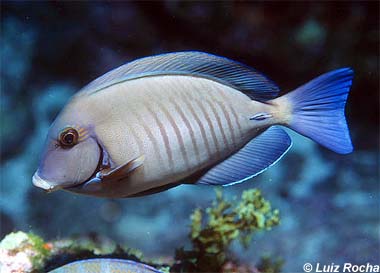
This pancake-shaped reef fish is blue-gray to brown colored with thin, dark bars down its sides. It is sometimes offered as a fresh catch locally, but can cause ciguatera poisoning in humans. Handle with care during an encounter because of the sharp spines hidden in the caudal peduncle (narrow area just before the tail).
These vegetarians play an important role on the reefs by eating the algae that can grow over the coral and kill it.
Order: Perciformes
Family: Acanthuridae
Genus: Acanthurus
Species: chirurgus
Common Names
Common names in English include doctorfish and black doctorfish. Other language names include barbeiro (Portuguese), barbero rayado (Spanish), chirurgien docteur (French), navajon cirujano (Spanish), navajon rayado (Spanish), pololec chirung (Polish), sangrador rayado (Spanish), yokoshimahagi (Japanese). These common names originate from the small, sharp spine-like structure that lies along each side of the caudal peduncle. This is referred to as a “scalpel,” and is as sharp as its name suggests. It is believed to be used during fights with other fish for dominance and for defense against predators.
Importance to Humans
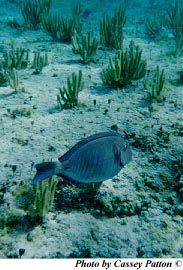
The flesh is of good quality, however is not highly valued in most locations. This fish may also cause ciguaterra poisoning if eaten. Ciguatera poisoning is caused by fish consuming dinoflagellates (microalgae) that occur on dead corals or other algae. The dinoflagellates have a toxin that builds up in the fish’s liver, and if it reaches a certain level, it can cause poisoning to humans who eat the doctorfish. Poisoned people report having gastrointestinal problems for up to several days, and a general weakness in their arms and legs. It is very rare to be afflicted with ciguatera poisoning. Doctorfish are collected commercially for the aquarium trade.
Danger to Humans
An unwary human who tries to handle the doctorfish risks the chances of being badly cut by the caudal spine. These spines, on both sides of the caudal peduncle, are extended from the body when the fish becomes excited. The quick, thrashing sideways motion of the tail can produce deep wounds that result in swelling and discoloration, posing a high risk of infection. The pain can last for hours, until eventually subsiding into a dull ache. It is believed that some species of Acanthurus have venom glands while others do not. The spines are used only as a method of protection against aggressors, wounds only occur through handling of the fish.
Conservation
> Check the status of the doctorfish at the IUCN website.
The IUCN is a global union of states, governmental agencies, and non-governmental organizations in a partnership that assesses the conservation status of species.
Geographical Distribution
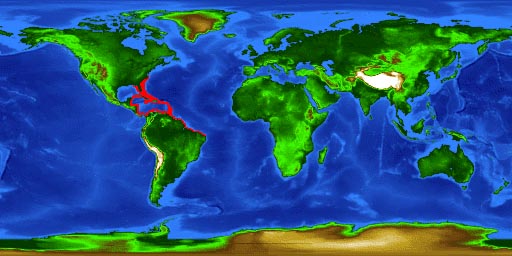
This is the most wide-ranging of the species of Acanthurus in the Atlantic and is found from Massachusetts to Brazil, including the northern Gulf of Mexico and the Caribbean. It can also be found along the tropical western coast of Africa.
Habitat
Doctorfish are associated with shallow marine waters 6-130 feet (2-40m) over rock bottom or coral reef habitats. They are also frequently found foraging through inshore seagrass beds, traveling with schools of A. bahianus.
Biology
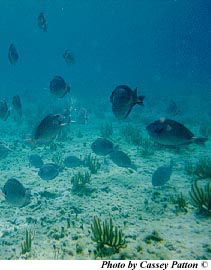
Distinctive Features
This fish is high-bodied and compressed, resulting in a pancake-like shape. The eye is high on the head and the mouth is small. The dorsal fin is continuous. Of particular interest is the sharp, scalpel-like spine that is located on each side of the body on the caudal peduncle. This spine can be extended and used to fend off aggressive encounters. Its teeth, specialized for scraping algae, are spatula-like in shape, close together, and notched on the edges.
Coloration
The doctorfish can vary slightly in its overall color. It can change from blue-gray to dark brown, and pale or darken dramatically. The dark color phase is commonly observed on reefs while the pale color phase is seen over sandy bottoms. It has from ten to twelve thin, dark, vertical bars visible on the sides.
A broad, pale area is often present at the caudal fin base while the caudal spine sheath is dark. These bars separate the doctorfish from other regional Acanthurus species like the blue tang and the surgeonfish. There is a faint blue ring that encircles the scalpel on each side. The edges of the anal, dorsal, and caudal fins are blue, regardless of the body color.
Size, Age, and Growth
Doctorfish frequently reach about 12 inches (30 cm) in length, with a maximum size of 14 inches (35 cm).
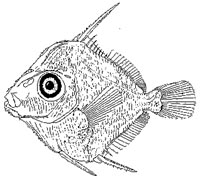
Food Habits
The doctorfish is a diurnal grazer, feeding on mostly algae and organic detritus found on compacted sand and rock bottoms. They form small groups and are often observed schooling with ocean tangs (A. bahianus) as they feed on algae.
During feeding, doctorfish tend to hand their heads down while picking at the algae with its specialized teeth. Since the fish swallows its food whole, it must depend on a unique adaptation for breaking up the food into smaller pieces. It has a gizzard-like organ in the intestine that is partially filled with sand particles. This organ apparently helps the fish to grind up food prior to digestion.
Reproduction
Doctorfish spawning is a group event that occurs during evening hours. The eggs are small, less than a millimeter in diameter. The eggs are pelagic, each containing a single droplet of oil for flotation. The eggs hatch in twenty-four hours, revealing small, translucent larvae. The newly hatched larvae are referred to as acronurus because it was once thought to represent a separate genus of fishes, the genus Acronurus. The acronurus is diamond-shaped and laterally compressed, with a head shaped like a triangle. It has large eyes and prominent pectoral fins. The dorsal fins, anal fins, and scales begin to develop when the acronurus reaches 2-6 mm in length. The scalpel does not appear until the acronurus reaches about 13 mm in length.
Late post-acronurus drift inshore, where they change into juveniles. The acronurus lose their silver color and turn brown. Their profiles become round.The prominent dorsal and anal spines that are characteristic to the acronurus reduce, while the scalpel gets bigger. Complete metamorphosis takes about a week, after which two-inch long juveniles settle onto the bottom of a suitable inshore habitat. Juveniles grow rapidly, attaining sexual maturity in as little as nine months. The adults can reach sizes of up to 14 inches (35 cm) in length.
Predators
The doctorfish is preyed upon by large piscivorous fishes including tunas.
Taxonomy
The doctorfish, Acanthurus chirurgus, was first described in 1787 by Bloch. Acanthurus is derived from the Greek “acantha” which means thorn, and the Greek “oura” which means tail. Synonyms that refer to this species include Acanthurus phlebotomus Valenciennes 1835.
Prepared by: Casey Patton